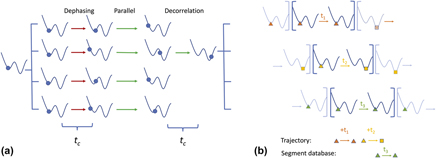Crossref Citations
This article has been cited by the following publications. This list is generated based on data provided by
Crossref.
Huang, Rao
Wen, Yuhua
Voter, Arthur F.
and
Perez, Danny
2018.
Direct observations of shape fluctuation in long-time atomistic simulations of metallic nanoclusters.
Physical Review Materials,
Vol. 2,
Issue. 12,
Zamora, R. J.
Perez, D.
Martinez, E.
Uberuaga, B. P.
and
Voter, A. F.
2018.
Handbook of Materials Modeling.
p.
1.
Aristoff, David
2019.
Generalizing Parallel Replica Dynamics: Trajectory Fragments, Asynchronous Computing, and PDMPs.
SIAM/ASA Journal on Uncertainty Quantification,
Vol. 7,
Issue. 2,
p.
685.
Rest, J.
Cooper, M.W.D.
Spino, J.
Turnbull, J.A.
Van Uffelen, P.
and
Walker, C.T.
2019.
Fission gas release from UO2 nuclear fuel: A review.
Journal of Nuclear Materials,
Vol. 513,
Issue. ,
p.
310.
Rosenzweig, J B
Majernik, N
Robles, R R
Andonian, G
Camacho, O
Fukasawa, A
Kogar, A
Lawler, G
Miao, Jianwei
Musumeci, P
Naranjo, B
Sakai, Y
Candler, R
Pound, B
Pellegrini, C
Emma, C
Halavanau, A
Hastings, J
Li, Z
Nasr, M
Tantawi, S
Anisimov, P.
Carlsten, B
Krawczyk, F
Simakov, E
Faillace, L
Ferrario, M
Spataro, B
Karkare, S
Maxson, J
Ma, Y
Wurtele, J
Murokh, A
Zholents, A
Cianchi, A
Cocco, D
and
van der Geer, S B
2020.
An ultra-compact x-ray free-electron laser.
New Journal of Physics,
Vol. 22,
Issue. 9,
p.
093067.
Wang, Bei
Chen, Yifeng
and
Hou, Chaofeng
2020.
Communication Optimization Strategy for Molecular Dynamics Simulation on Sunway TaihuLight.
p.
571.
Wang, Bei
Chen, Yifeng
and
Hou, Chaofeng
2020.
Algorithms and Architectures for Parallel Processing.
Vol. 11944,
Issue. ,
p.
75.
Zamora, R. J.
Perez, Danny
Martinez, E.
Uberuaga, Blas Pedro
and
Voter, Arthur F.
2020.
Handbook of Materials Modeling.
p.
745.
Duda, E. V.
and
Kornich, G. V.
2020.
Simulation of Vacancy Diffusion in a Crystal by the Method of Temperature-Accelerated Dynamics.
METALLOFIZIKA I NOVEISHIE TEKHNOLOGII,
Vol. 42,
Issue. 3,
p.
341.
Garmon, Andrew
and
Perez, Danny
2020.
Exploiting model uncertainty to improve the scalability of long-time simulations using Parallel Trajectory Splicing.
Modelling and Simulation in Materials Science and Engineering,
Vol. 28,
Issue. 6,
p.
065015.
Zamora, R. J.
Perez, D.
Martinez, E.
Uberuaga, B. P.
and
Voter, A. F.
2020.
Handbook of Materials Modeling.
p.
1.
Garza, Richard B.
Lee, Jiyoung
Nguyen, Mai H.
Garmon, Andrew
Perez, Danny
Li, Meng
Yang, Judith C.
Henkelman, Graeme
and
Saidi, Wissam Abdo
2021.
Atomistic Mechanisms of Binary Alloy Surface Segregation From Nanoseconds to Seconds Using Accelerated Dynamics.
SSRN Electronic Journal ,
Garmon, Andrew
Ramakrishnaiah, Vinay
and
Perez, Danny
2022.
Resource allocation for task-level speculative scientific applications: A proof of concept using Parallel Trajectory Splicing.
Parallel Computing,
Vol. 112,
Issue. ,
p.
102936.
Garza, Richard B.
Lee, Jiyoung
Nguyen, Mai H.
Garmon, Andrew
Perez, Danny
Li, Meng
Yang, Judith C.
Henkelman, Graeme
and
Saidi, Wissam A.
2022.
Atomistic Mechanisms of Binary Alloy Surface Segregation from Nanoseconds to Seconds Using Accelerated Dynamics.
Journal of Chemical Theory and Computation,
Vol. 18,
Issue. 7,
p.
4447.
Andrews, James
Gkountouna, Olga
and
Blaisten-Barojas, Estela
2022.
Forecasting molecular dynamics energetics of polymers in solution from supervised machine learning.
Chemical Science,
Vol. 13,
Issue. 23,
p.
7021.
Mistry, Aashutosh
Yu, Zhou
Peters, Brandon L.
Fang, Chao
Wang, Rui
Curtiss, Larry A.
Balsara, Nitash P.
Cheng, Lei
and
Srinivasan, Venkat
2022.
Toward Bottom-Up Understanding of Transport in Concentrated Battery Electrolytes.
ACS Central Science,
Vol. 8,
Issue. 7,
p.
880.
Militzer, Matthias
Hutchinson, Christopher
Zurob, Hatem
and
Miyamoto, Goro
2023.
Modelling of the diffusional austenite-ferrite transformation.
International Materials Reviews,
Vol. 68,
Issue. 7,
p.
725.
Chalamet, Loïc
Rodney, David
and
Shibuta, Yasushi
2023.
Coarse-grained molecular dynamic model for metallic materials.
Computational Materials Science,
Vol. 228,
Issue. ,
p.
112306.
Perez, Danny
and
Lelièvre, Tony
2024.
Comprehensive Computational Chemistry.
p.
360.
Tang, Hao
Li, Boning
Song, Yixuan
Liu, Mengren
Xu, Haowei
Wang, Guoqing
Chung, Heejung
and
Li, Ju
2024.
Reinforcement Learning‐Guided Long‐Timescale Simulation of Hydrogen Transport in Metals.
Advanced Science,
Vol. 11,
Issue. 5,






